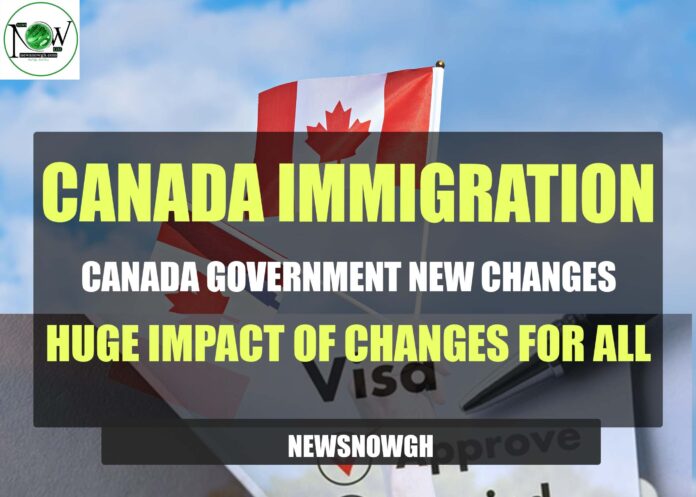Canada Government New Changes: Huge Impact of Changes for All | Canada Immigration
Canada has announced intentions to lower the number of temporary foreign workers permitted entry into the nation, marking a dramatic shift in policy. This choice follows continuous discussions regarding how immigrant labor affects Canada’s economy and job market.
The blog attempts to represent a wider plan to alter the country’s labor force and address issues about job prospects for Canadian citizens and permanent residents. This update explores the factors that led to the policy change, the possible ramifications for different industries, and the reactions from national stakeholders.
Introduction
Following a historic spike in temporary foreign employment that some experts claim has exacerbated unemployment among immigrants and young people, Prime Minister Justin Trudeau stated on Monday that the federal government will cut back on the number of these workers.
In addition, Trudeau stated that the government is considering lowering the annual cap on the number of permanent residents Canada accepts. This would be a significant policy shift following years of rising immigration numbers under the Liberal administration.
Amidst a severe labor shortage following the COVID-19 pandemic, the government decided to relax limitations on temporary foreign workers (TFWs). This move increased the number of low-wage workers.
With rare exceptions for “food security sectors” like agriculture, food and fish processing, construction, and healthcare where there are still severe staffing shortages, Trudeau said employers in high unemployment areas—where the unemployment rate is six percent or higher—will not be allowed to hire low-wage TFWs.
The government announced yet another reversal, stating that companies will no longer be permitted to use the TFW program to hire more than 10% of their whole workforce.
Fall Immigration Level Plan: Taking Both Temporary and Permanent Residents Into Account
The Liberals are “ongoingly” discussing immigration and the labor market, according to Prime Minister Justin Trudeau. He also announced this fall that the government will unveil an “immigration levels plan” that takes into account both temporary and permanent residents.
Low-wage TFWs will also only be able to work one-year contracts instead of the two that they currently have. “We need Canadian businesses to invest in training and technology, not increasing their reliance on low-cost foreign labor,” Trudeau stated. “It’s not fair to Canadians struggling to find a good job, and it’s not fair to those temporary foreign workers, some of whom are being mistreated and exploited.”
TFW Workers Increased Quickly Over Six Years
When the nation recovered from the epidemic with enormous gaps in the labor market, Employment Minister Randy Boissonnault stated that there was more slack in the employment market than there is today. In June, the overall unemployment rate was 6.4%, but the “newcomer” or immigrant unemployment rate is currently 11.6%, according to the Bank of Canada’s most recent monetary report.
According to federal statistics, the jobless rate for youths, or those between the ages of 15 and 24, is even higher at 13.5%, the highest level in ten years. According to official data, the number of low-wage TFW workers increased from 15,817 in 2016 to 83,654 in 2023. This sector includes workers in food services as well as construction and healthcare.
Reasons Canada Is Modifying Its Program for Temporary Foreign Workers
When proposing adjustments to the temporary foreign worker program, the federal government “must be careful,” according to Immigration Minister Marc Miller, to avoid plunging Canada into a recession. According to Minister of Employment Randy Boissonnault, he is not ready for Canada’s rural and remote areas to become completely devoid of the low-wage temporary foreign worker stream.
According to Boissonnault, the adjustments made today will result in approximately 65,000 fewer low-wage TFWs, returning the population to pre-pandemic levels.
Tightening regulations on temporary workers, according to Housing Minister Sean Fraser, who served as Immigration Minister when the TFW regulations were first loosened in 2022, will also help reduce market stress, particularly at the lower end of the market where there is intense competition for more affordable homes.
“We expect the changes made today could potentially reduce the pressure on tens of thousands of housing units across the country,” Fraser stated.
“Broken” Immigration System, claims a Conservative MP
The deputy leader of the Conservative Party, Melissa Lantsman, stated that the government’s move to limit TFWs is evidence that it is “walking back the disastrous policies of Sean Fraser who, at the time, was immigration minister.” He is in charge of housing repairs now that he has broken our immigration system.”
Senior director of policy at the University of Ottawa-based Smart Prosperity Institute, Mike Moffatt has written about the TFW program’s effects on teenage unemployment. The reduction in low-wage TFWs, according to Moffatt, is “a great first step, but it’s only a first step.” Many more things still need to be done.
There’s been an increase in TFWs taking entry-level office jobs, he said, and the high-wage component of the program needs to be adjusted as well because there are enough Canadian workers available to fill such positions.
Meanwhile, an organization that advocates for migrant rights condemned the government’s choice to curtail the program.
Further Details
Syed Hussan, executive director of the Migrant Workers Alliance for Change, stated, “High unemployment, low wages, and unaffordable housing are not caused by immigrants and migrants — these are caused by employer exploitation and policy failures.”
In his statement, he said that “racism and discrimination,” rather than the flood of foreign labor, are the real causes of the high unemployment rates among immigrants. “Migrants build communities, and they deserve equal rights and respect, not scapegoating,” he stated.
Follow us on Newsnowgh.com to stay updated on the latest information regarding work permits, visa application processes, paths to permanent residency, and visa-sponsored employment.


